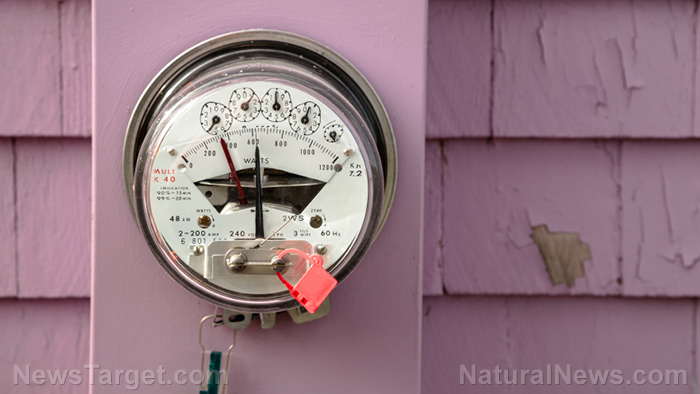DIY backup power system options when SHTF
05/14/2019 / By Janine Acero

A good prepper ensures that his or her home will have backup power, such as a battery system, in case of an outage.
To set up a backup power system for home use, you must first know your home power needs. Determine a system that has the specific purpose of supporting the house, which means identifying what most appliances consume. You can check the sticker on it for its power usage, or you can use a meter that will measure power usage. The total consumption is the primary concern when picking batteries and charging them. (h/t to MDCreekmore.com)
Battery ratings
After identifying your home power needs, you can choose the type of battery to use. Here are common battery ratings to help you out.
Amp-hour. AH is a common rating for battery capacity. AH rating is calculated by multiplying the current (in amperes) by time (in hours) that the current is drawn. Variations of the AH rating is the most used battery rating. It most commonly signifies a deep-cycle, marine or industrial battery.
Marine. Marine batteries can be deep-cycle, hybrids, or pure hokum. True marine batteries are designed for dual use of engine starting and house service and are therefore hybrids. These have spongy, porous plates that are thicker, larger, and heavier than automotive batteries. A true marine battery can tolerate up to 50 percent discharge and up to 80 percent for deep-cycle and industrials. An auto battery will quickly die at such discharge rates.
Deep-cycle. Deep-cycles have much thicker plates – nearly seven times thicker than an auto battery – but high-quality batteries have solid plates while others are made of a lead powder composite. Lead powder plates allow for much more rapid charging but also deteriorate much faster. Solid or denser and thicker plates are slower-charging but have a much longer service life.
Deep-cycles withstand more abuse and thousands of charging cycles and have much longer service life than the other two types, but they don’t have as great a cranking or burst power, being designed to provide power over long periods. These are best for use with inverter systems. They are identifiable by their cost of two to three times that of other types and 20-hour AH ratings.
Golf cart. This battery is generally a quasi-deep-cycle similar to marine — not as good as batteries with solid plates, but better than auto/marine types. Usually set up in banks of six-volt batteries, it has a greater number of plates to provide longer periods of use under a constant power demand and deep discharging. T-105, US2200, and GC-4 are common identifiers. Golf cart batteries can discharge up to 80 percent without being damaged. They are not better for use with inverters than true deep-cycle batteries.
Industrial batteries. Industrial or commercial deep-cycle batteries are used in battery-powered machinery such as forklifts, sweepers, and floor cleaners. They are similar to golf cart batteries but are usually true deep-cycle types with much heavier and pure lead plates up to around 0.270 inches thick. These batteries can discharge up to 80 percent without being damaged.
AGM batteries. Absorbed Glass Mat batteries contain the electrolyte absorbed in a mesh of Boron-Silicate glass fibers, which means there is no fluid electrolyte to leak or spill, and they will not suffer from freeze damage. AGM batteries require little to no maintenance. They can be charged with conventional charges without fear of damage from modest overcharging. Moreover, water loss is said to be reduced by 99 percent because hydrogen and oxygen are recombined within the battery. AGM batteries also have a lower self-discharge rate of 1-3 percent versus up to 15 percent with standard lead-acid batteries.
AGM batteries are widely used in battery backup power systems and solar systems. However, they cost around two to three times more than standard batteries. The best use for AGM batteries is for installations where it is hard or impossible to ventilate charging fumes such as the interiors of sailboats.
Choosing the battery type for your backup system
As a prepper, you must buy batteries within your allotted budget. True deep-cycle batteries have AH ratings that are high but so is their price. Many lead-acid and AGM batteries are 6V which means you would need to buy them in pairs for adequate reserve power.
Multiple batteries in a pack should all be purchased at the same time, and be the same type. Newer batteries will degrade faster if mixed with older ones. Searching online can give you full details of different battery types.
There is also the decision of how many to buy. Solar experts recommend buying twice the number of batteries that you think you will need. Their justification is that you should not use more than 50 percent of the battery’s reserve to prolong its life.
Based on personal experience, decide on how much battery power will meet your expected daily consumption. From this, you can add at least 20 percent, which should be enough to cover for any unexpected consumption.
Knowing the lifespan of your chosen battery will allow you to plan your next purchase ahead of time. Deep-cycle batteries typically last four to five years – that is the lifespan, not the warranty, so expect to replace them. As the end of your battery’s life is approaching, you can plan your next purchase one to two years in advance, accounting for any expansion in a capacity that you may need. (Related: Revolutionary battery can self-assemble and charge your phone in SECONDS.)
Sources include:
Tagged Under: appliances, bug out, electricity, emergency, Gear, homesteading, how to, off grid, power, Power Outage, preparedness, prepper, prepping, self-reliance, SHTF, survival



















